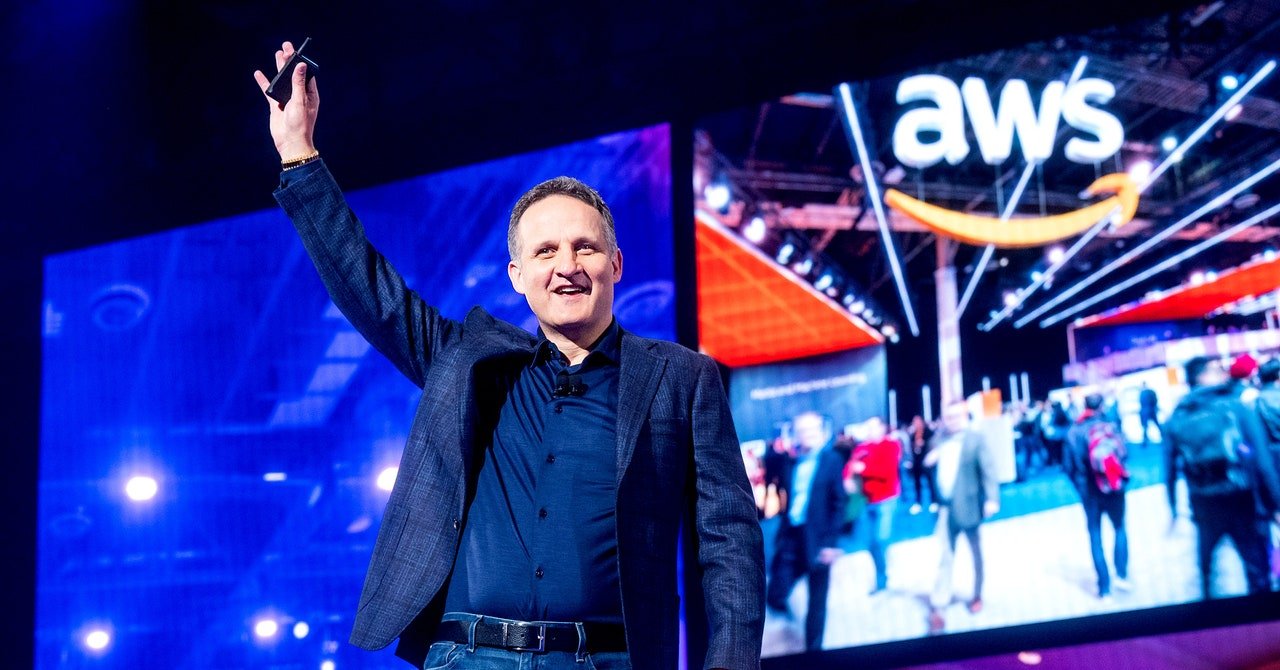
As CEO of Amazon’s dominant cloud computing platform AWS, Adam Selipsky is one of the most powerful people in computing at a time when the industry is racing to adopt generative artificial intelligence. Although a fan of the technology, he also has a warning for anyone trying to make sense of the moment: Some AI companies at the center of the storm are massively overhyped.
Selipsky likens the generative AI rush to the early days of the dotcom bubble, when expectations spread that the internet would transform many industries almost overnight. Although in the long term the internet was indeed transformative, in the short term many projects came to nothing, and swathes of Silicon Valley companies went bust.
“If you go back to, say, 1997 and you ask, ‘Was the internet underhyped or overhyped?’ I would argue it was underhyped,” says Selipsky, who spoke with WIRED during a conference at Harvard Business School on February 4. “But if you then ask, ‘Were the companies who were the leaders then dramatically overhyped?’ Yes, they were.” Selipsky didn’t name the companies he has in mind. The most prominent in generative AI so far include Amazon’s cloud rival Microsoft and its partner and ChatGPT developer OpenAI.
Selipsky says that companies looking for ways to apply generative AI to their own business or industry need to be careful they aren’t misled by the hype. “Many companies and organizations are struggling to understand, ‘Out of these hundred pilots or proofs-of-concept that I have going on, which ones do I take into production?’” he says. “And they’re starting to see that it can be very expensive once they go into production.” The implication? A lot of generative AI projects hastily born over the past year may not have long to live. The technology can be expensive to deploy because of the many high-powered computer chips required for generative AI projects.
Amazon has not been widely seen as a leader in the generative AI boom, which was triggered by OpenAI’s surprise hit ChatGPT—perhaps giving Selipsky reason to downplay its impact. But despite the problems he sees, he says that Amazon does see a long-term technological shift underway. “We do believe that generative AI will be transformative, will change the way that virtually every application in the world works, and will eventually transform the way that people work,” he says.
Company executives and boards in all kinds of industries are currently under pressure to explore and experiment with generative AI. Investors, academic studies, and industry reports have all predicted major disruption ahead for businesses, with trillions of dollars in future revenue on the table.
At the same time, although generative AI has clearly boosted the businesses of AI providers like OpenAI and some hardware companies like Nvidia, the payoffs from generative AI for business applications have been less clear. Problems such as algorithmic bias and hallucination continue to plague generative AI deployments, and disputes over copyrighted data fed to AI models have also cast a legal cloud over some applications of the technology.
Selipsky first joined AWS as a marketing executive in 2005 but left in 2016 to become CEO of analytics company Tableau, which was later sold to Salesforce. He was hired back to lead AWS in 2021 by Andy Jassy, who had just vacated that position to succeed Jeff Bezos as Amazon CEO, and had originally hired Selipsky to his first stint at Amazon.
Although Amazon has been the clear market leader in cloud computing for years, its primary rival, Microsoft, has crucial support in the contest for AI thanks to its being the primary backer of ChatGPT maker OpenAI. Amazon’s other main cloud rival, Google, long seen as a leader in AI development, has gone all-in on generative AI, aggressively developing a rival to ChatGPT and plugging the technology into many of its services.
Although Amazon still dominates, Microsoft and Google saw their cloud businesses grow at a faster clip in the final quarter of 2024, and both credited AI for providing a boost.
Microsoft’s latest quarterly report said that its revenue from its cloud business grew 30 percent compared to the same quarter a year before. Google said that its cloud business grew by 26 percent. AWS revenue grew 13.2 percent year on year in the fourth quarter of 2024.
Microsoft last month saw its market capitalization swell to more than $3 trillion, buoyed by the excitement around generative AI and its cloud platform Azure. The company has committed $13 billion to OpenAI since 2019. Although the terms of the deal have not been made public, the relationship gave the software giant early access to OpenAI’s underlying AI model, GPT-4, and also provides a cut of OpenAI’s future profits, according to the AI developer’s unusual governance model.
Amazon made its own Titan language model generally available in September, months after GPT-4 was offered by OpenAI. AWS is also hedging its bets, providing cloud customers with access to AI models from several startups competing with OpenAI, including startups Anthropic, Cohere, and AI21.
Selipsky says that, like in past technological shifts, there will be multiple important providers of generative AI. “There’s not going to be one model to rule them all,” he says. “Customers will need a broad and heterogeneous set of capabilities. They’ll need to experiment.”
Amazon is also making a few big wagers on AI companies that are attracting a fair amount of hype. Last September it announced that it would invest $4 billion in Anthropic, a startup founded by early OpenAI employees that has been developing cutting-edge language models of its own and a multifunctional chatbot named Claude.
As well as a minority stake in the startup, Amazon’s deal with Anthropic will see the company use an AI chip developed by AWS, called Tranium, to build future models. Nvidia remains the dominant supplier of chips used to train AI models, but like a sneaker brand’s deal with a top athlete, the Anthropic deal could help Amazon advertise the fact that its hardware can provide top-flight performance. Anthropic’s projects could also provide valuable data on the performance of chips and the needs of AI developers. “We will work very closely with them to make their models better, and they will work closely with us to help make our chip technologies better,” Selipsky says.
Amazon’s Anthropic deal and other generative AI projects have dragged the company and its rivals into new regulatory territory. President Joe Biden’s executive order on AI requires companies to disclose when they are training AI above a threshold, chosen to keep the US government informed of projects more powerful than AI systems that are currently available. The order also requires cloud providers to disclose when foreign customers are training AI models of this size, due to concerns about AI potentially undermining US national security.
Selipsky says that governments will need to balance concerns that AI is being developed responsibly with the need to encourage innovation among domestic tech champions and protect customer’s data. “It’s important that companies or organizations with good intentions not be slowed down for national security reasons, and that we all continue to innovate,” he says. “Data sovereignty is very, very important to our customers around the world.”
In recent years, there has been a surge in excitement and hype surrounding generative artificial intelligence (AI) technologies. These AI systems are designed to generate new content, such as images, music, or text, that is indistinguishable from human-created content. However, some experts are drawing comparisons between the current generative AI hype and the infamous dotcom bubble of the late 1990s.
One prominent voice in this comparison is Teresa Carlson, Vice President of Worldwide Public Sector at Amazon Web Services (AWS). Carlson, who has witnessed both the dotcom bubble and the rise of AI technologies, believes that caution is necessary when it comes to the current generative AI hype. She argues that just like the dotcom bubble, there is a risk of overinflating expectations and overvaluing companies that are solely focused on generative AI.
During the dotcom bubble, numerous internet-based companies emerged with lofty promises but failed to deliver sustainable business models. Investors poured money into these companies, driving up their valuations to astronomical levels. However, when the bubble burst, many of these companies collapsed, leaving investors with significant losses.
Carlson warns that a similar scenario could unfold with generative AI. While the technology holds immense potential and has already demonstrated impressive capabilities, there is a danger of overestimating its current capabilities and underestimating the challenges it still faces. She emphasizes the importance of distinguishing between companies that are genuinely advancing the field of AI and those that are merely capitalizing on the hype.
One key concern is the ethical implications of generative AI. As these systems become more sophisticated, they raise questions about intellectual property rights and the potential for misuse. For example, deepfake technology, a form of generative AI, can create highly realistic videos that manipulate or impersonate individuals. This poses significant risks in terms of misinformation and privacy violations.
Another challenge lies in the limitations of current generative AI models. While they can produce impressive results, they often require vast amounts of data and computational power. This restricts their accessibility and practicality for many applications. Additionally, generative AI models can be prone to biases present in the training data, leading to unintended consequences and reinforcing societal inequalities.
Despite these challenges, generative AI has the potential to revolutionize various industries. It can aid in creative endeavors such as art, music, and storytelling, enabling new forms of expression and innovation. It can also enhance virtual reality experiences, video game design, and even drug discovery.
To avoid a potential bubble burst, Carlson suggests a measured approach to investing in generative AI. She advises investors to carefully evaluate companies based on their long-term viability, business models, and ethical considerations. Furthermore, she emphasizes the importance of collaboration between industry, academia, and policymakers to address the challenges associated with generative AI and ensure its responsible development.
In conclusion, while generative AI holds immense promise, it is crucial to approach the current hype with caution. Drawing parallels to the dotcom bubble, Amazon’s Cloud Executive Teresa Carlson warns against overinflating expectations and overvaluing companies solely focused on generative AI. By acknowledging the ethical concerns and limitations of current models, and by fostering collaboration and responsible development, we can harness the potential of generative AI while avoiding the pitfalls of a speculative bubble.






